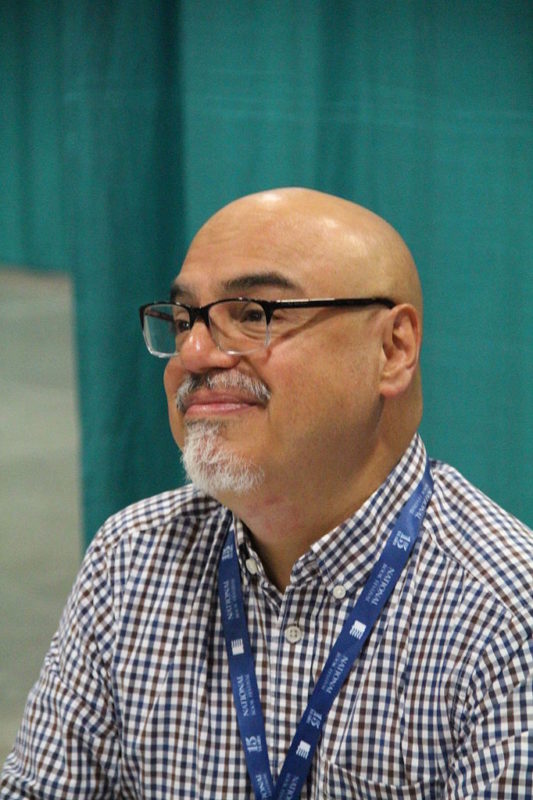Do the students in my US History survey need convincing that the past has an influence on the present, that it isn’t just stuff that happened a long time ago, that “the past is never dead,” etc.? Maybe they don’t. Maybe they know it in their guts but still require proof.
Some people teach history not by period but by theme, and some teach from the present day backward, I’ve heard. I understand the motivation. Teaching history in chronological order may work against the proof-gathering mentioned above. When we come to the chapter on the colonial period, we’re kind of stuck in the colonial period. But the history that influences the present isn’t divided up that way. When the past touches our lives, it does so out of order—in a collage of eras, persons, and events.
Héctor Tobar has demonstrated this beautifully in his July New Yorker essay, “The Assassin Next Door.” It’s an essay steeped in US History in its most iconic outlines: slavery, immigration, race and class, the Civil War and its legacy, the Civil Rights Movement, the recurring white supremacist and nativist surges, one of which we’re suffering now. Tobar, who teaches English and Latino Studies at UC-Irvine, jumbles this up in a personal story.
The premise seems flimsy at first. In 1967, when Tobar was a boy, living in a duplex in an East Hollywood neighborhood, James Earl Ray also lived for some months—across the fence—before he traveled to Memphis in April and assassinated Martin Luther King. Tobar has no memory of Ray, didn’t know him, likely never even laid eyes on him or heard his name. He was only five years old, after all. It was much later he learned that he and his parents had been neighbors to Ray during this significant period. He’d happened to read Killing the Dream, Gerald Posner’s book about the assassination, which details Ray’s activities in the year or so prior to the crime. Tobar’s connection to the assassin, then—having been discovered in the pages of a book–is a matter that must be wholly imagined.

Héctor_Tobar, 2015, at the National Book Festival. Photo by fourandsixty.
Tobar makes it work. Folded into his childhood memories are insights into the intersection of white poverty and white supremacist ideas, drawn from Posner’s research. The result is a meditation on the transient neighborhoods of urban America which serve as living spaces for the marginalized—for immigrants such as Tobar’s Guatemalan parents, and for “American drifters,” such as Ray. Immigrant families, aspirational and innovative, can make these spaces vibrant and create in them the experiences that live long in memory. For the drifters, these spaces can exacerbate self-loathing, and in Ray’s case, racial hate.
The craft on display in this essay is quite splendid—except that “on display” is the precisely wrong way to put it. Where are the transitional phrases, the markers which guide a reader through the steps of an argument? They aren’t necessary. Structure is so absorbed in content as to be rendered invisible. Years ago, I read a thin book by Robert Bly called Leaping Poetry. Bly’s claim was that the joy of poems by writers such as Lorca and Cesar Vallejo comes from quick, associative leaps between images, which the reader is able to follow without effort. Tobar is writing prose, not image-centered poetry, but his essay made me remember Bly’s idea. Tobar puts a number of stories in play–his own, Ray’s, the nation’s past, the nation’s present–and shifts smoothly from one to another, sometimes within the same brief paragraph. A good deal of “psychic substance,” as Bly would call it, is being hauled around here, but it’s weightless; it’s out of sight.
This method mirrors the point I wanted to make–that periodization breaks down in present experience. Stories fold in on one another; points on the timeline mix up and blur. Tobar’s mother is pregnant with him and about to give birth; a black activist neighbor named Booker Wade is called upon to drive her to the hospital. She’s been praying to Saint Martin de Porres, a Peruvian son of a slave and patron saint of racial harmony, and comes to believe that Wade is an answer to prayer. He becomes a friend and agrees to be named the baby’s godfather. Martin is chosen as Tobar’s middle name, and a few years later, another activist, another Martin, is shot and killed. “In the years that followed,” Tobar writes, “my family’s success in this country became associated in my mind with the blood and the sacrifice of black people.” The essay dramatizes grounds for solidarity between Latinos and African Americans while giving each of the groups their due.
That’s of concern of mine because these are my students. The institution where I teach is 53% Latinx, and 30% African American. These percentages run higher in the lower level, general ed courses that I mostly teach. It’s incumbent upon me to try to understand my students’ agendas, to be sensitive to ‘whose history’ is the history I choose to teach. As a middle-aged white guy, that’s not easy. I expect to make mistakes; I keep my eyes and ears open. I aim to read US history critically, as an analytical practice, and not perhaps as they’ve heard it before, as a story of triumph to pass along. Still I wonder how it feels to my students. It was their forebears, their folks who did the bulk of the suffering, enduring, and resisting of the actual stuff that makes up so much of the content of the course.
Tobar’s final paragraphs (spoiler alert!) contain this sentence: “Like many other Latino residents of this country, I derive a sense of power from observing the lives of people who cannot see the full measure of my humanity.” He’s describing, at least in part, both the process and the result of education. While I’m not sure I wholly trust the sentence, I took some assurance from it.

0